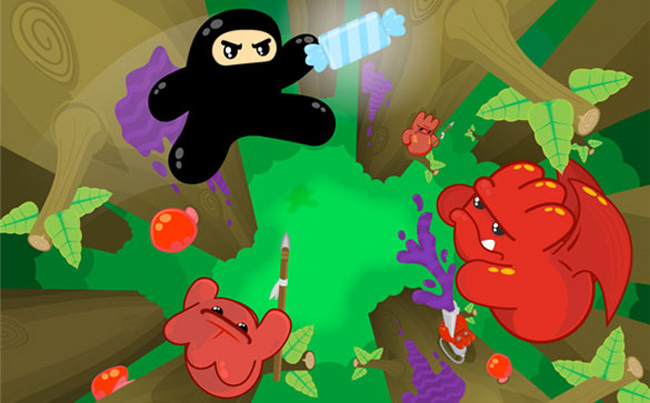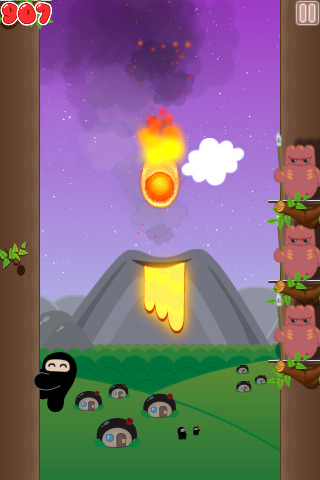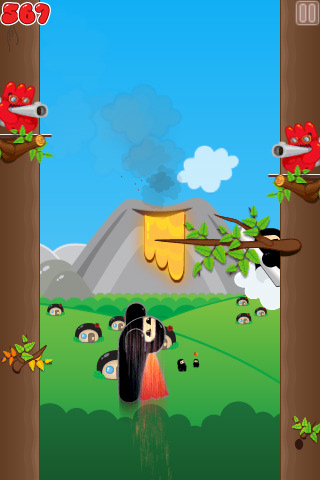
Contributed by: Toby Davis
Not many games can claim to be addictive from the start, but then again I haven’t played an addictive ninja game for a long time. After personally putting in countless gaming hours on my wife’s iPad playing NinjaTown: Trees of Doom morning and night, I thought it was time to ask some random questions about this game with Katy M. Smith, Producer for developer Venan Entertainment.

Toby Davis: Can you tell us about your job title and your part in the game’s development?
Katy M. Smith: Sure! I was the Producer on Ninjatown: Trees of Doom! This means it was my responsibility to make sure the game development progressed at a reasonable rate. I was also in charge of making sure all of the different people working on the game had the same goal in mind for the end product. In addition to that, I dabbled a bit in designing portions of the game, and acted as a quality control “sanity check” for our milestones.
TD: From my perspective it appears that this game has no “button” controls, but three touch: left side of the screen, right side of screen and the pulling down with branches. How many other variations of controls did you come up with before deciding that this is what you wanted?
KMS: There were probably about three or four different methods we seriously considered for moving the ninja up the tree. Interestingly enough, the hardest thing to settle on weren’t the controls, but how the ninja moved. We considered having the ninja always automatically climbing the tree (like Canabalt). Changing the ninja to user controlled was probably the most controversial decision made during development, but I think the game is much better for it. We also tried controlling the game with only swiping to jump. We figured out that was a little too finicky and made the game too hard to control. One of the things we decided early on was that if something was easy for a ninja to do, it should be easy for the player to do. This means the final control scheme had to be as simple as possible, because ninjas are awesome at climbing trees.

TD: The tree branches in the game are kind of a double edge sword. They may help you out get up higher, but what if you want to climb right past them? Can you give a bit of history on the creation of the branches?
KMS: Initially, we had the game set up so that you had to jump onto the branches in order to use them. By default, you would run right past them if you touched them. This was when the game was still in that “always running / Canabalt” style of gameplay. The branches were created so you could take a breath during the game and not constantly feel like you had to keep running. We liked the feeling of flinging the ninja off the branches, so when the overall running mechanic changed, we left the branches, because they were fun. However, you could still jump over the branches or run past them. This meant it was possible to get stuck in situations where you can’t get by an obstacle. Another one of our goals was to make the game so that you’re never killed by unfair level design. This means there’s always a way to get by an obstacle. The only way we could ensure that you can always get through every obstacle was to make the branches sticky. That is why you have to use the branches when you touch them.
TD: How were the helpful items — smoke bomb, pink bubble, hour glass, mustache and cape — picked from the world that Shawnimal created for the game? Also, were there any items or enemies that didn’t make it to the final cut, and why?
KMS: We initially had a list of about ten different items that would act as power ups. As we conceptualized and play tested the game, we realized there was a lot of overlap between the different items. We tried to condense it down to be as simple as possible. We approached the powerups from two fronts. First, we had this world that Shawnimal created that’s full of these fantastic things like the moustachio and the super ninja. We tried to think of powers that would associate with those items. On the other hand, we had ideas for some powers that would be neat, like a teleport or a shield of some kind. We looked for things that could be related to ninjas and fit Ninjatown as well. That’s how we came up with the sugar smoke bomb and the bubblegum shield. One of the ideas for a power-up that didn’t make it was a grappling hook. It would let you tap back to the same side of the tree if you accidentally jumped across. We wanted to add an “oh crap!” ability that could save if you were nearly dead. We ended up cutting it because we didn’t have enough time to fully develop it before release.
For enemies, it was a similar story. We had other enemies from Shawnimal’s universe that we wanted to get into game. The Dark Syrup Cloud was one that we didn’t get in. The cloud would have dropped dark syrup rain in a particular side of the tree and the ninja would have to avoid it. Since it was too much like the fireballs, we pulled it in order to stay as simple as possible.

TD: What is the development time on a game like this, and can fans of this game expect to see any extras or DLC down the road?
KMS: From the time we settled on a final concept to launch on the App Store was about ten weeks. However, we spent several months prior to that working out what type of game we were going to make. We were able to get the game completed quickly because we were able to compartmentalize the different aspects of the game, and then iterate on them without going cross-department. This means that while design was working out how the obstacles were going to be arranged, programming was adding code using colored rectangles, and art could work on the ninja animations. It’s a process that worked pretty well for us, and we will be using it on the updates to Trees of Doom. We definitely plan on updating the game regularly with cool new stuff. The first update should be out in early June.
TD: Do you have any tips for anyone who plays the game to help them get further up the tree?
KMS: The biggest trick to learn is when to do the “high jump” and when to do the “low jump”. If you just tap the opposite side of the tree, you will do a “low jump” that will only move you up the tree a tiny bit when the ninja moves across. If you press and hold the screen, you will do a “high jump.” This will move you up the tree quite a bit when you jump to the other side. Mastering when to do the low vs. high jump will help you easily move up the tree.
Ninjatown: Trees of Doom can be found in the iTunes app store
Images courtesy Venan Entertainment

1 Comment